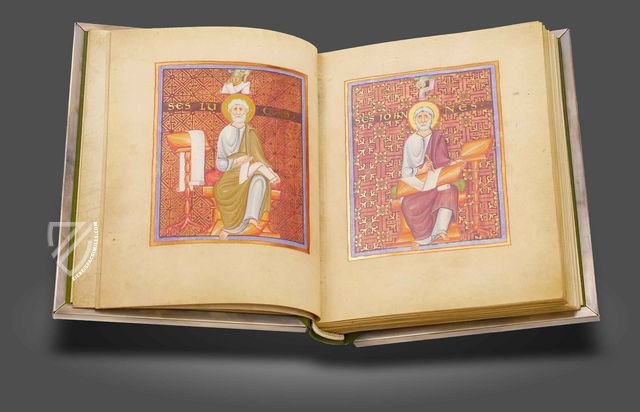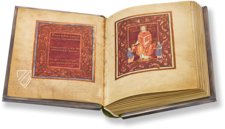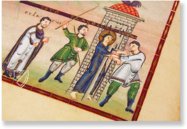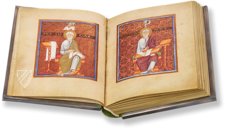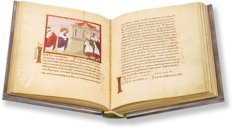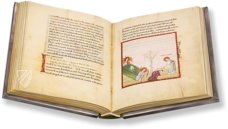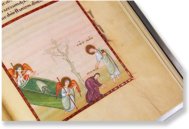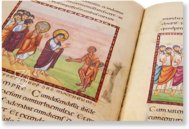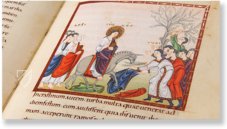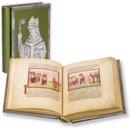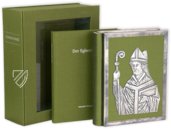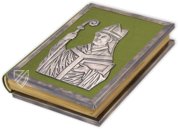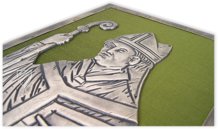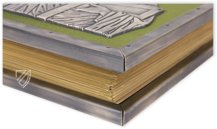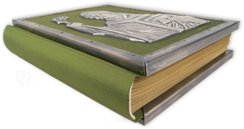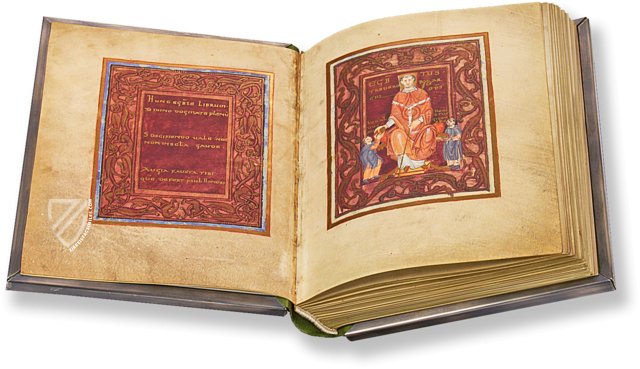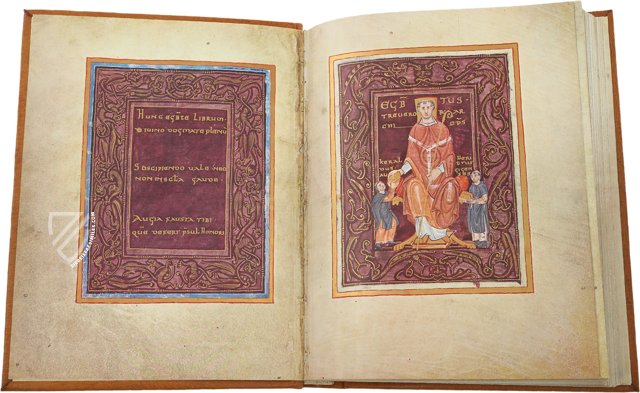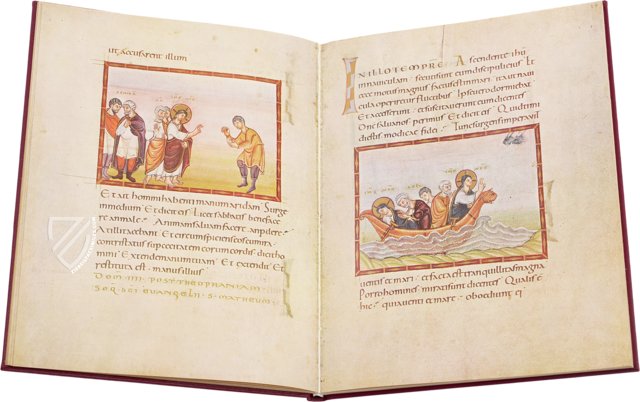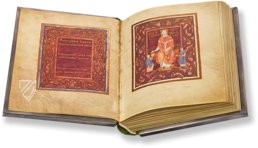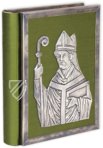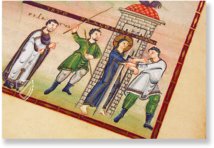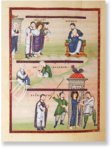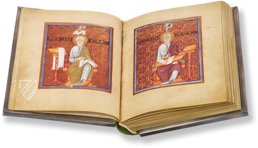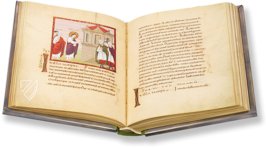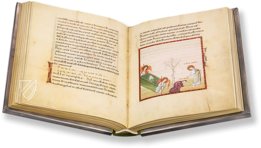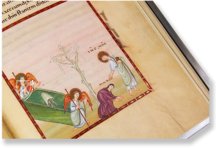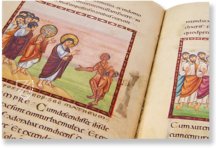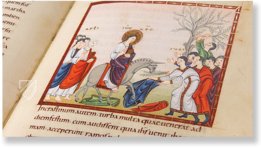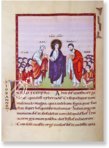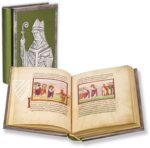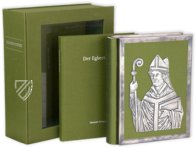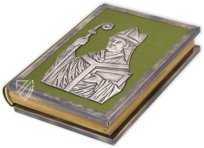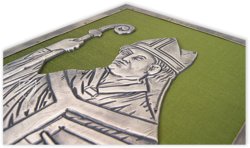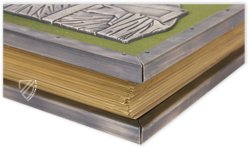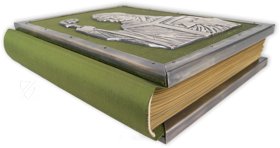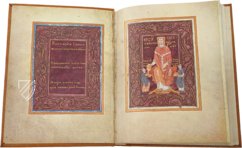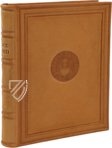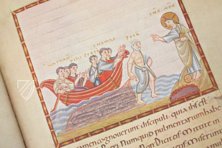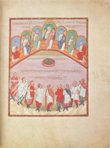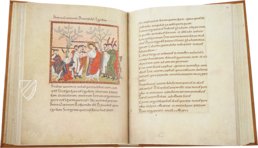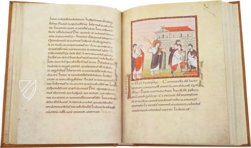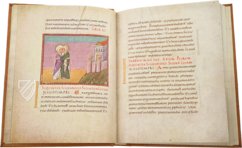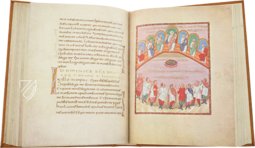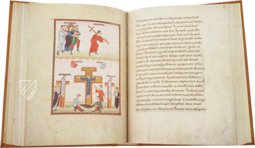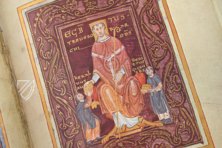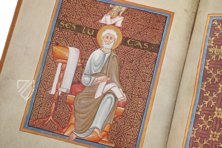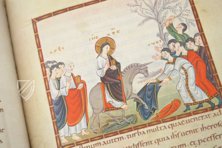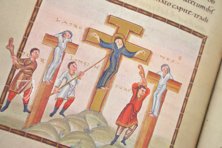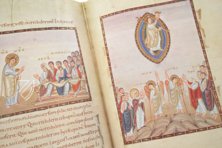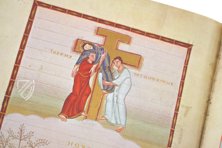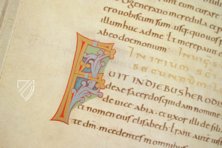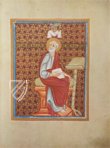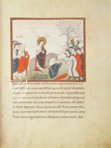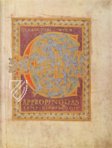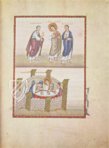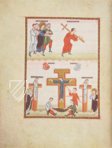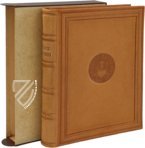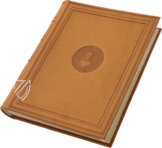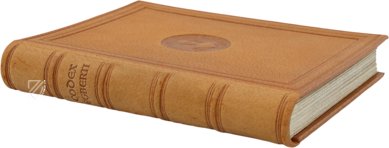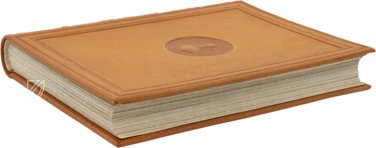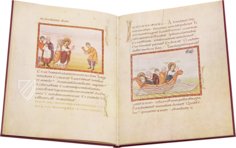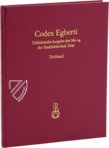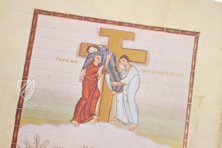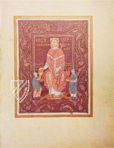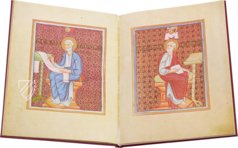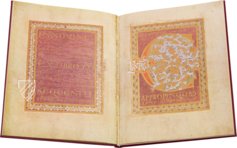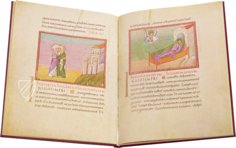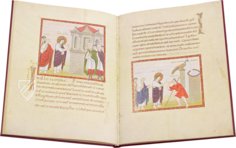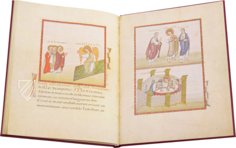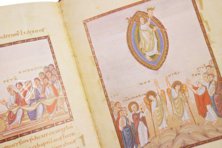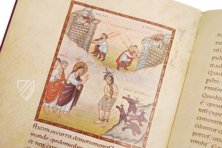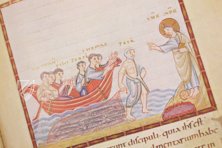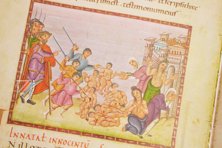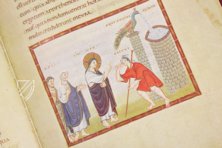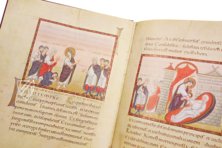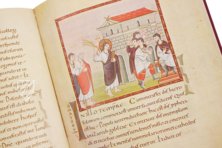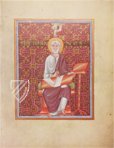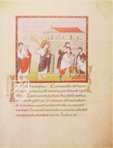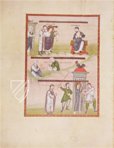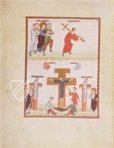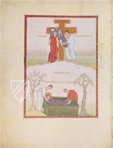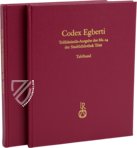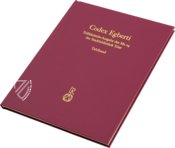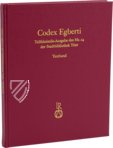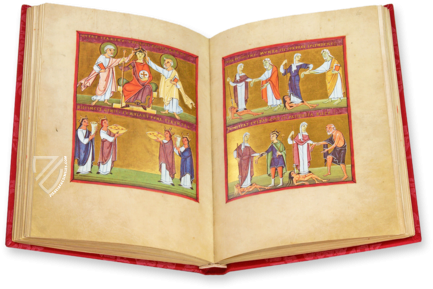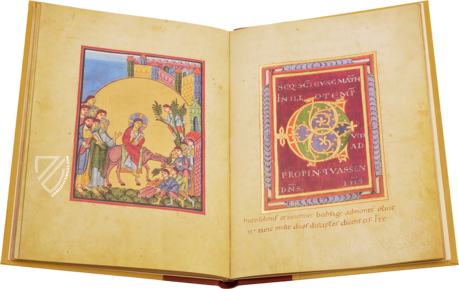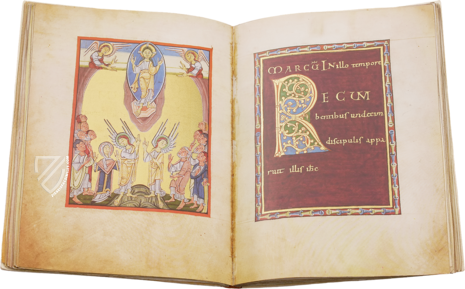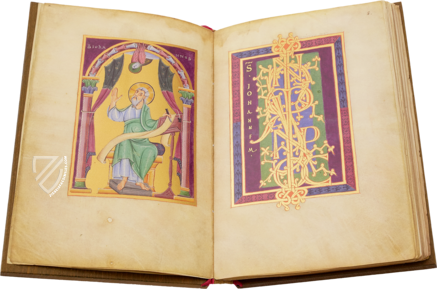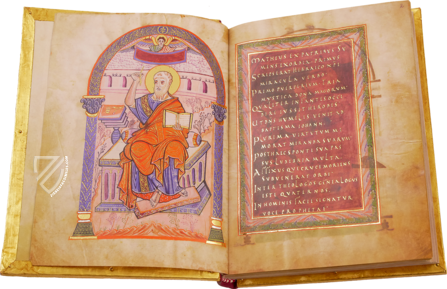Codex Egberti
(1,000€ - 3,000€)
The Codex Egberti is not only the oldest codex worldwide, which presents the wondrous and painful story of the life and deeds of Christ in pictures, but is simultaneously one of the most exciting and splendid codices of Ottonian illumination and has been a UNESCO World Documentary Heritage since 2004. The Evangelistary, which contains the gospel texts that were read during Mass in the course of a year, was commissioned by Archbishop Egbert of Trier and created between 980 and 993 in the famous scriptorium of Reichenau Abbey. Two talented Reichenau friars illuminated the manuscript under the direction of the so-called Gregory Master, who was renowned as a leading illuminator of the time. They embellished the incredibly precious manuscript with a total of 56 dreamlike, spiritual miniatures in high-quality colors and rich gold and silver decoration. While the work opens with several pages in gold and purple, the stories from the Vita Christi appear against pastel, often cloudy backgrounds.
Egbert-Codex
During the time of the Ottonian emperors, an illumination style developed within the Holy Roman Empire that distinguished itself in its monumental and narrative miniatures. Today, the illuminated manuscripts of the Ottonian style count among the most valuable manuscripts in the history of illumination. A magnificent codex from this art-historical period is the so-called Codex Egberti. This work was made for Egbert, the Archbishop of Trier, and is the first codex in the world whose pictorial decoration was concerned with the life of Christ. The Book contains 56 miniatures, whose design was predetermined and overseen by a talented illuminator with the name of convenience “Gregory Master”. The illuminated pages sparkle and shimmer in magnificent colors and noble pictorial backgrounds. Additionally, over 240 decorative initials adorn the pages of the splendid codex.
Art from the Reichenau Monastery
Archbishop Egbert von Trier, is considered by historians to be a one of the greatest lovers and collectors of books during the second half of the 10th century. The great patron of scholarship and art worked with the Reichenau Monastery, which was one of the most important centers of European art at that time. Egbert’s trusted scribe and illuminator was the Master of the Restrum Gregorii, the Gregory Master, who lived in the scriptorium of the Abbey of Trier and carried on correspondence with contemporary illuminators. The master’s art is strongly influenced by Insular and Byzantine Illumination. His knowledge and talents are displayed in the seven miniatures of the codex that he personally created himself. The remaining miniatures were completed by the monks Kerald and Heribert of Reichenau. Both of the gifted painters closely adhered to the pictorial program worked out by the Gregory Master, so that the miniatures of the Egbert codex tell the tale of the life of Christ in interrelated pictures.
A Historically Significant Work
This Codex Egberti is a Gospel pericopes or evangelistary, which contained the gospel texts that were read during Mass in the course of a year. Egbert commissioned it for performing Mass and it was used in St. Paul’s in Trier until the 18th century. During the Second World War, it was next stored in a bombproof tunnel in the Pallien quarter of Trier, but in September of 1944 it was nonetheless transported to the library of the University of Gießen for safe keeping in the face of the advancing Americans. This library was largely destroyed by a bombing on December 11, yet the Codex Egberti miraculously survived the attack. Alongside other Reichenau manuscripts, it was admitted to the UNESCO World Cultural Heritage list in April of 2004.
Impressive Miniature Painting
The Codex Egberti is the oldest manuscript that recounts the Life of Jesus Christ in Miniatures. The sublime, spiritual likenesses represent the events of Christ’s life from birth up to the Ascension and depict the Savior’s miracles in the Holy Land, some of which are to be found in no other manuscripts. The miniatures are clearly influenced by paradigms from Late Antiquity and Byzantium, though the artists simultaneously developed new iconographic ideas in their painting. The work opens with a double-page portrait of the bishop in gold and purple. Two monks are depicted at the feet of Egbert, namely the artists Kerald and Heribert, who present the work to the bishop. Four vivid, full-page depictions of the Evangelists follow this monumental portrait. Hereupon follow 51 narrative, diligently-composed miniatures concerning the life and works of Christ. The pictures show excitingly depicted groups of people furnished with lifelike details against shimmering, dreamlike backgrounds. This effect was achieved through a mysterious color scheme that mixes soft pastel colors with delicate gold leaf and silver.
Codicology
- Alternative Titles
- Egbert-Codex
- Size / Format
- 330 pages / 27.0 × 21.0 cm
- Origin
- Germany
- Date
- 990
- Epochs
- Style
- Genre
- Language
- Script
- Carolingian minuscule Uncial Rustic capitals Square capitals
- Illustrations
- 56 precious miniatures, some of them full-pages and magnificently executed with gold and purple, as well as over 240 decorative initials
- Content
- The oldest picture cycle of the Vita Christi
- Patron
- Archbishop Egbert of Trier (950–993)
- Artist / School
- Master of the Registrum Gregorii
Codex Egberti
Jesus Faces Pilate
Jesus is shown having been brought before Pontius Pilate, arms held back by his accusers. The Apostle Peter, depicted with white hair and a beard, watches and weeps bitter tears of shame for having denied Jesus three times, a scene known as the Repentance of Peter. Pontius Pilate is shown leaning forward and listening closely. “Now Jesus stood before the governor. And the governor asked Him, saying, ‘Are You the King of the Jews?’ Jesus said to him, ‘It is as you say.’” (Matt. 27:11)
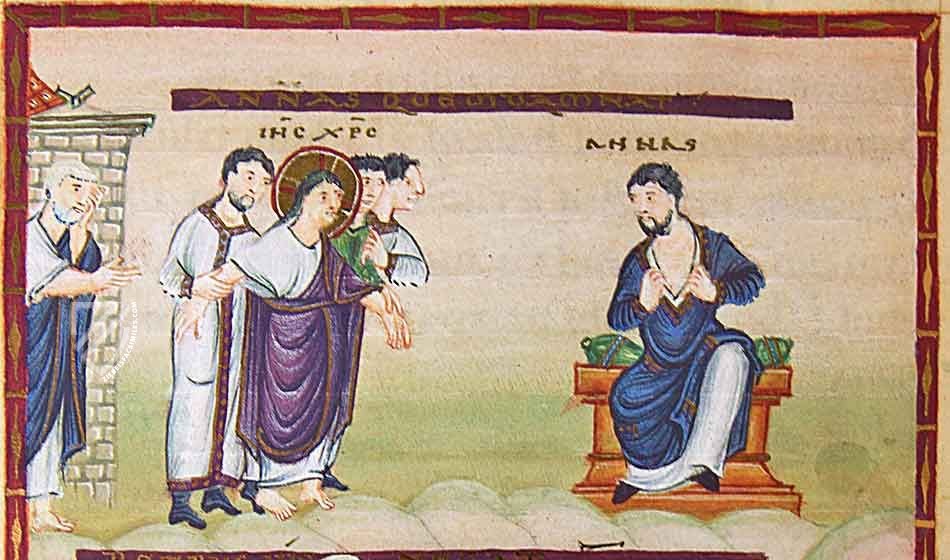
Codex Egberti
Presentation Miniature
The opening scene of this Ottonian manuscript shows an archetypal “presentation miniature” in which Archbishop Egbert is being presented with the manuscript at hand, which was commissioned either by or for him. Pages detailing the patronage of a manuscript were more common in Ottonian art than in other eras.
Egbert is presented in the monumental Ottonian style with typified, flattened facial features against a purple background and framed with stylized tendrils embellished with gold pen strokes and contained within another frame of gold leaf. The humble artists are only a fraction of Egbert’s size, stressing his importance. Egbert’s square halo indicates that he is alive as he accepts the codex with his right hand while he holds the crosier in his left.
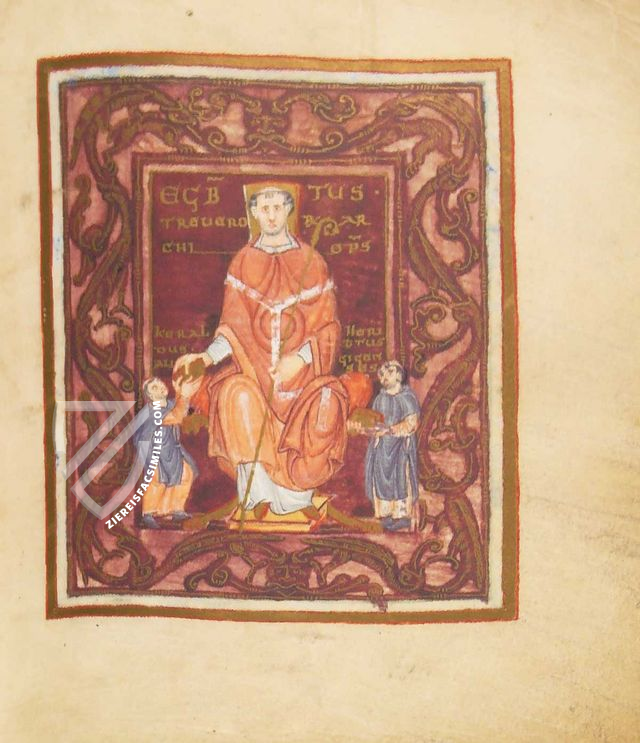
#1 Egbert-Codex
Language: German
(1,000€ - 3,000€)
#2 Egbert-Codex
Language: German
(1,000€ - 3,000€)
#3 Egbert Codex
Language: German
(under 1,000€)
- Treatises / Secular Books
- Apocalypses / Beatus
- Astronomy / Astrology
- Bestiaries
- Bibles / Gospels
- Chronicles / History / Law
- Geography / Maps
- Saints' Lives
- Islam / Oriental
- Judaism / Hebrew
- Single Leaf Collections
- Leonardo da Vinci
- Literature / Poetry
- Liturgical Manuscripts
- Medicine / Botany / Alchemy
- Music
- Mythology / Prophecies
- Psalters
- Other Religious Books
- Games / Hunting
- Private Devotion Books
- Other Genres
- Afghanistan
- Armenia
- Austria
- Belgium
- Belize
- Bosnia and Herzegovina
- China
- Colombia
- Costa Rica
- Croatia
- Cyprus
- Czech Republic
- Denmark
- Egypt
- El Salvador
- Ethiopia
- France
- Germany
- Greece
- Guatemala
- Honduras
- Hungary
- India
- Iran
- Iraq
- Israel
- Italy
- Japan
- Jordan
- Kazakhstan
- Kyrgyzstan
- Lebanon
- Liechtenstein
- Luxembourg
- Mexico
- Morocco
- Netherlands
- Palestine
- Panama
- Peru
- Poland
- Portugal
- Romania
- Russia
- Serbia
- Spain
- Sri Lanka
- Sweden
- Switzerland
- Syria
- Tajikistan
- Turkey
- Turkmenistan
- Ukraine
- United Kingdom
- United States
- Uzbekistan
- Vatican City
- A. Oosthoek, van Holkema & Warendorf
- Aboca Museum
- Ajuntament de Valencia
- Akademie Verlag
- Akademische Druck- u. Verlagsanstalt (ADEVA)
- Aldo Ausilio Editore - Bottega d’Erasmo
- Alecto Historical Editions
- Alkuin Verlag
- Almqvist & Wiksell
- Amilcare Pizzi
- Andreas & Andreas Verlagsbuchhandlung
- Archa 90
- Archiv Verlag
- Archivi Edizioni
- Arnold Verlag
- ARS
- Ars Magna
- ArtCodex
- AyN Ediciones
- Azimuth Editions
- Badenia Verlag
- Bärenreiter-Verlag
- Belser Verlag
- Belser Verlag / WK Wertkontor
- Benziger Verlag
- Bernardinum Wydawnictwo
- BiblioGemma
- Biblioteca Apostolica Vaticana (Vaticanstadt, Vaticanstadt)
- Bibliotheca Palatina Faksimile Verlag
- Bibliotheca Rara
- Boydell & Brewer
- Bramante Edizioni
- Bredius Genootschap
- Brepols Publishers
- British Library
- C. Weckesser
- Caixa Catalunya
- Canesi
- CAPSA, Ars Scriptoria
- Caratzas Brothers, Publishers
- Carus Verlag
- Casamassima Libri
- Centrum Cartographie Verlag GmbH
- Chavane Verlag
- Christian Brandstätter Verlag
- Circulo Cientifico
- Club Bibliófilo Versol
- Club du Livre
- CM Editores
- Collegium Graphicum
- Collezione Apocrifa Da Vinci
- Comissão Nacional para as Comemorações dos Descobrimentos Portugueses
- Coron Verlag
- Corvina
- CTHS
- D. S. Brewer
- Damon
- De Agostini/UTET
- De Nederlandsche Boekhandel
- De Schutter
- Deuschle & Stemmle
- Deutscher Verlag für Kunstwissenschaft
- DIAMM
- Droz
- E. Schreiber Graphische Kunstanstalten
- Ediciones Boreal
- Ediciones Grial
- Ediclube
- Edições Inapa
- Edilan
- Editalia
- Edition Deuschle
- Edition Georg Popp
- Edition Leipzig
- Edition Libri Illustri
- Editiones Reales Sitios S. L.
- Éditions de l'Oiseau Lyre
- Editions Medicina Rara
- Editorial Casariego
- Editorial Mintzoa
- Editrice Antenore
- Editrice Velar
- Edizioni Edison
- Egeria, S.L.
- Eikon Editores
- Electa
- Emery Walker Limited
- Enciclopèdia Catalana
- Eos-Verlag
- Ephesus Publishing
- Ernst Battenberg
- Eugrammia Press
- Extraordinary Editions
- Fackelverlag
- Facsimila Art & Edition
- Facsimile Editions Ltd.
- Facsimilia Art & Edition Ebert KG
- Faksimile Verlag
- Feuermann Verlag
- Folger Shakespeare Library
- Franco Cosimo Panini Editore
- Friedrich Wittig Verlag
- Fundación Hullera Vasco-Leonesa
- G. Braziller
- Gabriele Mazzotta Editore
- Gebr. Mann Verlag
- Gesellschaft für graphische Industrie
- Getty Research Institute
- Giovanni Domenico de Rossi
- Giunti Editore
- Graffiti
- Grafica European Center of Fine Arts
- Guido Pressler
- Guillermo Blazquez
- Gustav Kiepenheuer
- H. N. Abrams
- Harrassowitz
- Harvard University Press
- Helikon
- Hendrickson Publishers
- Henning Oppermann
- Herder Verlag
- Hes & De Graaf Publishers
- Hoepli
- Holbein-Verlag
- Houghton Library
- Hugo Schmidt Verlag
- Idion Verlag
- Il Bulino, edizioni d'arte
- ILte
- Imago
- Insel Verlag
- Insel-Verlag Anton Kippenberger
- Instituto de Estudios Altoaragoneses
- Instituto Nacional de Antropología e Historia
- Introligatornia Budnik Jerzy
- Istituto dell'Enciclopedia Italiana - Treccani
- Istituto Ellenico di Studi Bizantini e Postbizantini
- Istituto Geografico De Agostini
- Istituto Poligrafico e Zecca dello Stato
- Italarte Art Establishments
- Jan Thorbecke Verlag
- Johnson Reprint Corporation
- Josef Stocker
- Josef Stocker-Schmid
- Jugoslavija
- Karl W. Hiersemann
- Kasper Straube
- Kaydeda Ediciones
- Kindler Verlag / Coron Verlag
- Kodansha International Ltd.
- Konrad Kölbl Verlag
- Kurt Wolff Verlag
- La Liberia dello Stato
- La Linea Editrice
- La Meta Editore
- Lambert Schneider
- Landeskreditbank Baden-Württemberg
- Leo S. Olschki
- Les Incunables
- Liber Artis
- Library of Congress
- Libreria Musicale Italiana
- Lichtdruck
- Lito Immagine Editore
- Lumen Artis
- Lund Humphries
- M. Moleiro Editor
- Maison des Sciences de l'homme et de la société de Poitiers
- Manuscriptum
- Martinus Nijhoff
- Maruzen-Yushodo Co. Ltd.
- MASA
- Massada Publishers
- McGraw-Hill
- Metropolitan Museum of Art
- Militos
- Millennium Liber
- Müller & Schindler
- Nahar - Stavit
- Nahar and Steimatzky
- National Library of Wales
- Neri Pozza
- Nova Charta
- Oceanum Verlag
- Odeon
- Orbis Mediaevalis
- Orbis Pictus
- Österreichische Staatsdruckerei
- Oxford University Press
- Pageant Books
- Parzellers Buchverlag
- Patrimonio Ediciones
- Pattloch Verlag
- PIAF
- Pieper Verlag
- Plon-Nourrit et cie
- Poligrafiche Bolis
- Presses Universitaires de Strasbourg
- Prestel Verlag
- Princeton University Press
- Prisma Verlag
- Priuli & Verlucca, editori
- Pro Sport Verlag
- Propyläen Verlag
- Pytheas Books
- Quaternio Verlag Luzern
- Reales Sitios
- Recht-Verlag
- Reichert Verlag
- Reichsdruckerei
- Reprint Verlag
- Riehn & Reusch
- Roberto Vattori Editore
- Rosenkilde and Bagger
- Roxburghe Club
- Salerno Editrice
- Saltellus Press
- Sandoz
- Sarajevo Svjetlost
- Schöck ArtPrint Kft.
- Schulsinger Brothers
- Scolar Press
- Scrinium
- Scripta Maneant
- Scriptorium
- Shazar
- Siloé, arte y bibliofilia
- SISMEL - Edizioni del Galluzzo
- Sociedad Mexicana de Antropología
- Société des Bibliophiles & Iconophiles de Belgique
- Soncin Publishing
- Sorli Ediciones
- Stainer and Bell
- Studer
- Styria Verlag
- Sumptibus Pragopress
- Szegedi Tudomànyegyetem
- Taberna Libraria
- Tarshish Books
- Taschen
- Tempus Libri
- Testimonio Compañía Editorial
- Thames and Hudson
- The Clear Vue Publishing Partnership Limited
- The Facsimile Codex
- The Folio Society
- The Marquess of Normanby
- The Richard III and Yorkist History Trust
- Tip.Le.Co
- TouchArt
- TREC Publishing House
- TRI Publishing Co.
- Trident Editore
- Tuliba Collection
- Typis Regiae Officinae Polygraphicae
- Union Verlag Berlin
- Universidad de Granada
- University of California Press
- University of Chicago Press
- Urs Graf
- Vallecchi
- Van Wijnen
- VCH, Acta Humaniora
- VDI Verlag
- VEB Deutscher Verlag für Musik
- Verlag Anton Pustet / Andreas Verlag
- Verlag Bibliophile Drucke Josef Stocker
- Verlag der Münchner Drucke
- Verlag für Regionalgeschichte
- Verlag Styria
- Vicent Garcia Editores
- W. Turnowski Ltd.
- W. Turnowsky
- Waanders Printers
- Wiener Mechitharisten-Congregation (Wien, Österreich)
- Wissenschaftliche Buchgesellschaft
- Wissenschaftliche Verlagsgesellschaft
- Wydawnictwo Dolnoslaskie
- Xuntanza Editorial
- Zakład Narodowy
- Zollikofer AG

